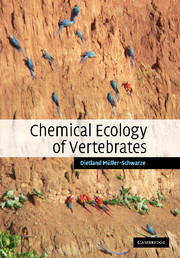Description
Chemical Ecology of Vertebrates
Author: Muller-Schwarze Dietland
Chemical Ecology of Vertebrates, first published in 2006, explores the chemically-mediated interactions between vertebrates and other animals and plants.
Language: English
Subject for Chemical Ecology of Vertebrates:
Approximative price 106.56 €
In Print (Delivery period: 14 days).
Add to cart
Chemical Ecology of Vertebrates
Publication date: 08-2012
Support: Print on demand
Publication date: 08-2012
Support: Print on demand
Approximative price 163.88 €
Subject to availability at the publisher.
Add to cart
Chemical ecology of vertebrates
Publication date: 09-2006
578 p. · 17x24.4 cm · Hardback
Publication date: 09-2006
578 p. · 17x24.4 cm · Hardback
Description
/li>Contents
/li>
Published in 2006, Chemical Ecology of Vertebrates was the first book to focus exclusively on the chemically-mediated interactions between vertebrates including fish, amphibians, reptiles, birds and mammals, and other animals and plants. Reviewing research in three core areas - pheromones (where the interactions are between members of the same species), interspecific interactions involving allomones (where the sender benefits) and kairomones (where the receiver benefits), it pulls together information from widely scattered technical literature in many different disciplines into a coherent whole. Chapters on the environment, properties of odour signals, and production and release of chemosignals set the stage for discussion of more complex behavioural topics. While the main focus is ecological, dealing with behaviour and interactions in the field, it also covers chemoreception, orientation and navigation, the development of behaviour and the practical applications of chemosignals.
1. The odorsphere: the environment for transmission of chemical signals; 2. Properties of vertebrate semiochemicals; 3. Odor production and release; 4. Chemical cues in orientation and navigation; 5. Chemoreception; 6. Signaling pheromones; 7. Priming pheromones; 8. Development of intra- and interspecific chemical interactions; 9. Chemical defense by animals; 10. Herbivores' exposure to chemical defenses of plants; 11. Kairomones and synomones; 12. Practical applications of semiochemicals; Glossary; References.
© 2024 LAVOISIER S.A.S.




